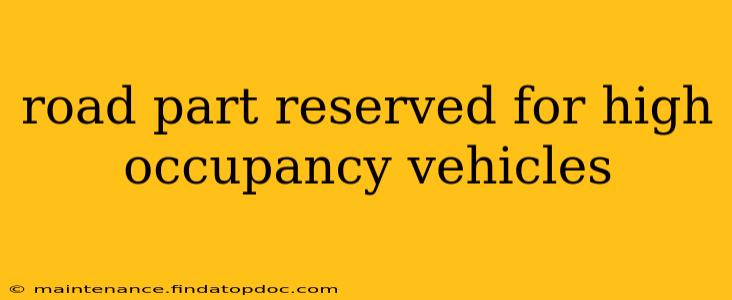High-Occupancy Vehicle (HOV) lanes, also known as carpool lanes, are designated roadways reserved for vehicles carrying a minimum number of passengers. These lanes aim to reduce traffic congestion, encourage carpooling, and promote more sustainable transportation options. This guide delves into the intricacies of HOV lanes, addressing common questions and providing valuable information for drivers.
What are HOV lanes?
HOV lanes are specific lanes on highways and roadways reserved for vehicles with a certain number of occupants. This number varies depending on the location and time of day. Typically, it ranges from two to three or more passengers, sometimes including motorcycles or clean-energy vehicles. The purpose is to incentivize people to share rides, thereby reducing the overall number of vehicles on the road and improving traffic flow. Failure to comply with HOV lane rules usually results in fines.
How many passengers are required for HOV lanes?
The number of passengers required to use HOV lanes isn't universal; it depends heavily on the specific location and even the time of day. Some areas may require two passengers during peak hours and only one during off-peak times. Others may have a minimum of three passengers, while certain regions may also permit solo drivers of electric or hybrid vehicles. Always check local signage for precise requirements before entering an HOV lane. Ignoring these requirements can lead to significant fines.
What are the benefits of HOV lanes?
The benefits of HOV lanes extend beyond just easing traffic congestion. They contribute to:
- Reduced Traffic Congestion: By encouraging carpooling, fewer vehicles occupy the road, resulting in smoother traffic flow, particularly during peak hours.
- Improved Air Quality: Fewer vehicles mean less vehicle emissions, leading to cleaner air in urban areas.
- Fuel Efficiency: Carpooling contributes to better fuel economy as fewer vehicles travel the same distance.
- Sustainable Transportation: HOV lanes promote environmentally friendly commuting habits.
What types of vehicles can use HOV lanes?
While the primary requirement is the minimum number of passengers, the specific vehicles permitted can vary. Many jurisdictions allow:
- Vehicles with the required number of passengers: This is the most common requirement.
- Solo drivers of clean-energy vehicles: Some areas grant access to solo drivers of electric or hybrid vehicles to incentivize the adoption of eco-friendly transportation.
- Motorcycles: Certain locations allow motorcycles to use HOV lanes regardless of the number of passengers.
- Buses and vans: These vehicles often have dedicated access to HOV lanes.
It's crucial to note: Local regulations dictate the specific vehicles allowed. Always check the signage for accurate information.
Are there fines for using HOV lanes incorrectly?
Yes, using HOV lanes improperly often results in significant fines. These fines are designed to deter misuse and maintain the integrity of the system. The exact amount of the fine varies depending on the jurisdiction.
What are the alternatives to using HOV lanes?
If you don't meet the occupancy requirements for HOV lanes, you can consider:
- Public Transportation: Utilize buses, trains, or subways for commuting.
- Cycling or Walking: Consider biking or walking, especially for shorter distances.
- Ride-sharing services: Use ride-sharing apps to find others traveling the same route.
By understanding the rules and regulations surrounding HOV lanes, drivers can contribute to a more efficient and sustainable transportation system. Remember, always check local signage for the most up-to-date requirements and avoid costly fines.
